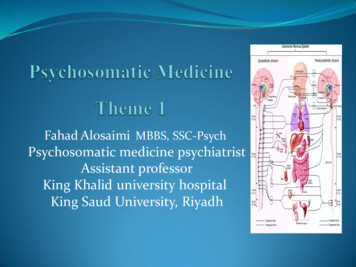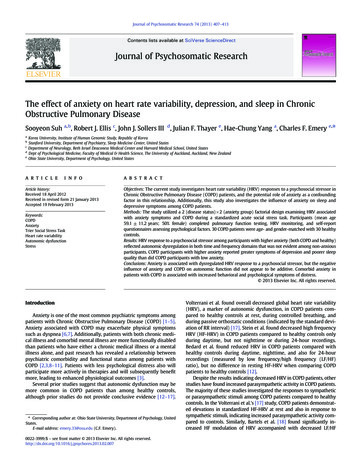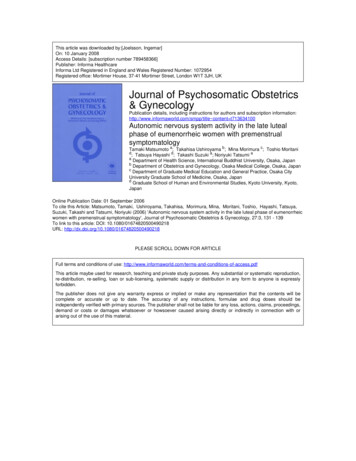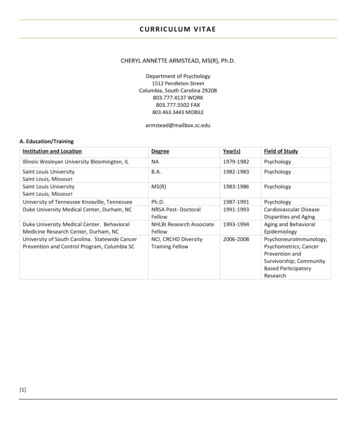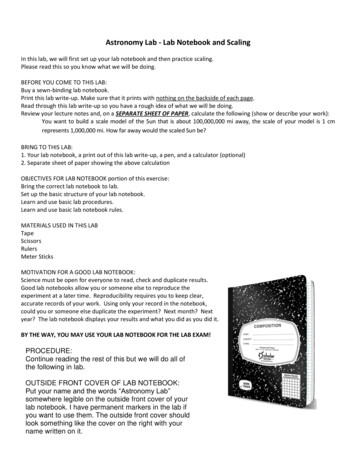
Transcription
Journal of Psychosomatic Research 77 (2014) 144–150Contents lists available at ScienceDirectJournal of Psychosomatic Research“A room full of strangers every day”: The psychosocial impact ofdevelopmental prosopagnosia on children and their familiesKirsten A. Dalrymple a,b,⁎,1, Kimberley Fletcher c,d,e,1, Sherryse Corrow f, Roshan das Nair g, Jason J.S. Barton c,d,e,Albert Yonas f, Brad Duchaine aaDepartment of Psychological and Brain Sciences, Dartmouth College, Hanover, USAInstitute of Cognitive Neuroscience, University College London, London, UKDepartment of Medicine (Neurology), University of British Columbia, Vancouver, CanadadDepartment of Ophthalmology and Visual Science, University of British Columbia, Vancouver, CanadaeDepartment of Psychology, University of British Columbia, Vancouver, CanadafInstitute of Child Development, University of Minnesota, Minneapolis, USAgDivision of Rehabilitation & Ageing, University of Nottingham, Nottingham, UKbca r t i c l ei n f oArticle history:Received 14 March 2014received in revised form 27 May 2014accepted 4 June 2014Keywords:ChildrenDevelopmental prosopagnosiaFace recognitionPsychosocialSocial developmentThematic analysisa b s t r a c tObjective: Individuals with developmental prosopagnosia (‘face blindness’) have severe face recognition difficulties due to a failure to develop the necessary visual mechanisms for recognizing faces. These difficulties occur inthe absence of brain damage and despite normal low-level vision and intellect. Adults with developmentalprosopagnosia report serious personal and emotional consequences from their inability to recognize faces, butlittle is known about the psychosocial consequences in childhood. Given the importance of face recognition indaily life, and the potential for unique social consequences of impaired face recognition in childhood, we soughtto evaluate the impact of developmental prosopagnosia on children and their families.Methods: We conducted semi-structured interviews with 8 children with developmental prosopagnosia andtheir parents. A battery of face recognition tests was used to confirm the face recognition impairment reportedby the parents of each child. We used thematic analysis to develop common themes among the psychosocial experiences of the children and their parents.Results: Three themes were developed from the child reports: 1) awareness of their difficulties, 2) coping strategies, such as using non-facial cues to identify others, and 3) social implications, such as discomfort in, and avoidance of, social situations. These themes were paralleled by the parent reports and highlight the unique social andpractical challenges associated with childhood developmental prosopagnosia.Conclusion: Our findings indicate a need for increased awareness and treatment of developmental prosopagnosiato help these children manage their face recognition difficulties and to promote their social and emotionalwellbeing. 2014 Elsevier Inc. All rights reserved.IntroductionFaces are the most distinctive cue to a person's identity [1] and, arguably the most important visual stimulus in our lives [2]. Very early in lifewe use faces to recognize our caregivers and interact with them. Inchildhood, face recognition is important for making friends and developing social skills. As children mature, face recognition plays a role infinding partners, building careers, and maintaining social relationships.Thus, face recognition is important for both interpersonal development⁎ Corresponding author at: Institute of Child Development, University of Minnesota, 51East River Parkway, Minneapolis, MN 55455, USA. Tel.: 1 612 626 6171.E-mail address: kad@umn.edu (K.A. Dalrymple).1These authors contributed 4.06.0010022-3999/ 2014 Elsevier Inc. All rights reserved.and status within the social world, beginning early in life and extendingthroughout adulthood.The importance of face recognition is highlighted by cases of developmental prosopagnosia (DP), a neurodevelopmental disorder characterized by severe face recognition difficulties in the absence of deficitsto low-level vision and intellect [3–5]. Although DP was once considered rare, recent reports suggest that it affects 2% of the population[6–8]. Despite this relatively high prevalence, only one study has directly examined the psychosocial consequences of DP in adults [9]. Participants reported feelings of embarrassment, guilt, and failure as a resultof their face recognition difficulties. They indicated fear and avoidanceof social situations, and, in extreme cases, chronic anxiety leadingto long-term social isolation, limited employment opportunities, andloss of self-confidence. The authors likened the psychosocial consequences of DP to those resulting from other disorders like stuttering
K.A. Dalrymple et al. / Journal of Psychosomatic Research 77 (2014) 144–150and dyslexia, that are commonly afforded special support andaccommodations [9]. These findings led the authors to conclude thatDP can have a lasting effect on formation and maintenance of socialrelationships.Only one case study has examined the social consequences of DPin childhood [10]. ‘Steve’ (13-years-old) depended on non-facialvisual cues such as clothing and hairstyle to identify others. Via semistructured interview he reported specific concerns with academics,social interactions, and safety. The author concluded that, “childrenwith prosopagnosia rarely have a wide circle of friends because friendships are difficult to develop and keep” (p.285) [10].In the present study, we conducted semi-structured interviews witheight children and their parents. The goal was to use thematic analysisto extract themes that would provide insight in to the psychosocialconsequences of impaired face recognition in a group of childrenwith DP.MethodParticipantsPotential participants were selected from a group of children whoseparents reported that their child experiences face recognition difficulties. Parents contacted us through our websites at Dartmouth College(www.faceblind.org) or the University of Minnesota (www.cehd.umn.edu/icd/research/yonaslab/). Children had to be English speaking,have no history of brain damage, have normal or corrected-to-normalvision, and have no diagnosis of Autism Spectrum Disorder (ASD) tobe included in the study. In all, eight children (3 female; mean age:9.25 years, range: 5–14 years) met the inclusion criteria and were classified as having DP (see diagnostic criteria below). There were no specific inclusion criteria for parents, who were included in the study if theirchildren met the inclusion criteria.Case descriptions of the eight children with DP are included inSupplementary Material 1. Information regarding participant identityhas been removed, and pseudonyms are used throughout. This studywas approved by the Behavioural Research Ethics Board at the University of British Columbia, the Institutional Review Board at the University145of Minnesota, and the Committee for the Protection of Human Subjectsat Dartmouth College. Informed consent was obtained for all participants and this study was carried out in accordance with The Code ofEthics of the World Medical Association (Declaration of Helsinki).ProcedureNeuropsychological assessmentChildren were assessed in their homes for general cognitive functioning (IQ, Wechsler Abbreviated Scale of Intelligence — II) [11], autistic tendencies (Autism-Spectrum Quotient — Adolescent Version [12],Children's Version [13]), face recognition deficits using the CambridgeFace Memory Test—Kids (CFMT-K) [14] and the Dartmouth FacePerception Test (DFPT), and for object memory using the CambridgeBicycle Memory Test (CBMT). The CBMT is matched to the CFMT-K informat and difficulty. The CFMT-K is designed to test face memoryand the DFPT is designed to test face perception. Our face recognitiontests are described in further detail in Supplementary Material 2. Neuropsychological results for each child can be found in Table 1. For comparison, data from control participants are provided in SupplementaryMaterial 3.Diagnostic criteriaVery few good tests of face recognition exist for children [15]. Giventhis lack of precedence, we designed our own tasks of face memory andface perception, and established a relatively conservative approachto diagnosis of DP. We took two primary factors into account whenclassifying children as having DP: 1) anecdotes from parents providedevidence of face recognition difficulties in daily life (see Case Descriptions, Supplementary Material 1), and 2) DFPT scores were greaterthan 2 standard deviations (SD) below the control mean.In adults, DP is typically diagnosed on the basis of face memoryscores. Most of the children who met our diagnostic criteria also scoredmore than 2 SD below the control mean on the CFMT-K (see Table 1),however, the version used for younger children suffers from floor effects. Thus, even though the younger children (Chloe and Lorraine)Table 1Neuropsychological assessments. Pseudonyms, age, and gender are listed for each child. Measures include IQ (WASI-II Wechsler Abbreviated Scale of Intelligence-II), Autism Quotient(AQ), face perception (Dartmouth Face Perception Test), face memory (Cambridge Face Memory Test—Kids), and object memory (Cambridge Bicycle Memory Test). IQ scores are indicatedwith percentile rank in parentheses. AQ scores are indicated with age-appropriate cut offs in parentheses. For DFPT, CFMT, and CBMT, scores that are N2SD below the control mean areindicated in with an * and in bold. Each child's scores were compared to scores from at least 12 children of the same age, except Chloe and Lorraine, whose scores were compared to scoresfrom 7-year-olds, and Thomas, whose scores were compared to scores from 12-year-olds. Chloe was 5 years, 10 months, and 20 days at the time of testing. Her IQ test was scored usingnorms from MParentEmmaAbigailJuliaJaneSophieJoanneJillLucyIQ — WASI-IIPerformance IQVerbal IQFull scale IQ120 (91st)138 (99th)133 (99th)112 (79th)122 (93rd)120 (91st)122 (93rd)132 (98th)131 (98th)102 (55th)134 (99th)122 (93rd)105 (63rd)113 (81st)111 (77th)117 (87th)120 (91st)122 (93rd)86 (18th)91 (27th)87 (19th)84 (14th)122 (93rd)104 (61st)AutismAutism quotient (cut off) 57 (N76)71 (N76)49 (N76)38 (N76)16 (N30)11 (N30)26 (N30)10 (N30)Face processingFace memory (CFMT kids, chance 33.3%)z-ScoreFace perception (DFPT, chance: 33.3%)z-Score37.5% 1.1635.0%* 3.66*43.8% 0.8240.0%* 3.17*37.5%* 2.03*40.0%* 2.21*52.0%* 2.35*42.5%* 2.98*56.9%* 3.86*65.0%* 2.57*34.7%* 6.94*30.0%* 7.12*51.4%* 3.26*47.5%* 6.63*38.9%* 4.71*35.0%* 8.58*Object processingObject memory (CBMT, chance 33.3%)z-Score77.1%0.5150.0% 1.2279.2% 0.3387.5%0.5568.1%0.0184.7%1.7872.2% 0.3948.6% 3.10Interview durationChildParent30 mins20 mins41 mins30 mins30 mins20 mins20 mins30 mins22 mins29 mins18 mins25 mins25 mins24 mins17 mins68 mins
146K.A. Dalrymple et al. / Journal of Psychosomatic Research 77 (2014) 144–150Table 2Child interview scheduleYoung people (aged 4 )1. Can you tell me a little bit about yourself? (Age, grade at school, people at home)2. Can you tell me what you like to do for fun/what you enjoy doing? (Why?)3. Can you tell me about school? (Favorite/worst: subjects, teachers, activities — why?)4. Can you tell me about your friends?5. Can you tell me some of the things that you're really good at doing? And what about things that you're really bad at doing?If the young person has already spoken about difficulty recognizing people go to question 6 and 7, if not go to question 8.6. Can you tell me a little bit more about your trouble recognizing people [use child's description of their difficulty] (good things, bad things, how does it make you feel, an example —can you tell me about a time )7. Can you tell me about any tricks you have to recognize people more easily? (Voice/clothes?)8. Some young people that I have spoken to have trouble knowing who people are when they first see them.a. Do you know anyone who might have this trouble recognizing faces?b. Is this something that happens to you? (For example, do you sometimes get your friends mixed up?)If the participant agrees go to question 9, if not go to question 10.9. Can you tell me a little bit more about the times when you get people mixed up? (Good things, bad things, how does it make you feel, an example — can you tell me about a time )10. Can you tell me about any tricks you have to recognize people more easily? (Voice/clothes?)Final Question for all participants:11. Thank you for telling me so much about yourself today. Before I go is there anything else that you want to tell me about yourself?scored near chance on the CFMT-K, their scores were within 2 SD fromthe mean. While our face memory test did not conclusively detect facememory impairments in these younger children, Chloe scored 43% ona test of familiar face memory that her mother designed, making severalfalse alarms and failing to identify her own face. Furthermore, at a theoretical level, we expect that individuals with impaired facial identityperception (e.g. all children in our final sample) will have impairedface memory because it is likely that facial identity recognition dependson effective facial identity perception. The strong correlation betweenperformance on face perception tasks and face memory tasks providesempirical support for this relationship [16,17].production, without focusing on previous research findings. This interactive process continued until each theme was refined, and a narrativecreated. Codes that did not fit with the ‘contour’ of the themes werereworked, labeled as miscellaneous, and at times discarded [23].Analysis of the entire data set aims to provide a sense of “predominant and important themes” (p. 83) [23], illustrating common experiences of children with DP and their parents. Deviations from thepattern of experiences in the transcripts were noted and made explicitin the narrative presented.InterviewsQuality assurance measures [24] were adhered to by the researchteam. Trustworthiness [25] and sensitivity to context [25] were soughtthrough maintaining a decision-making audit-trail, and by KF maintaining a reflexive diary. This was important as KF was employed as apostdoctoral researcher investigating prosopagnosia at the time ofstudy completion. Rather than to demonstrate inter-rater reliability,which would be inconsistent with the epistemological position takenby the researcher (critical realist), KF consulted with co-author RdNthroughout the analysis process. This consultation, as well as the use ofdirect participant quotes in this article, ensured transparency, enablingthe source of the themes to be traced through the analysis process.Sixteen semi-structured interviews (children: n 8; parents: n 8,all mothers) were conducted by KF over Skype and were audiorecorded. Child and parent interviews were separate (Tables 2 and 3)and based on interview schedules developed by the research team,which focused on areas of interest for this study (e.g. coping/social/psychological adjustment). Most child interviews were conductedwith the parent sitting quietly in the room. Parent interviews wereconducted without the children present.Data analysisAudio recordings of all interviews were transcribed verbatim.Transcripts were manually analyzed by KF using thematic analysis(for a full description of this method, see [18]). The authors did notaim for theoretical saturation [19] as this has been reported as inflexible[20] and implies that the process of collecting data on this topic iscomplete [21]. Instead the authors aimed for ‘theoretical sufficiency’[21], allowing a build-up of emerging constructs and acknowledgingthat collecting further data could produce additional themes.KF approached data analysis from a critical realist position; thusacknowledging that individuals make meaning from experience andparticipant accounts reflect their perception of reality [23]. As such KFwas looking for semantic (or explicit) themes, and interpretation wasintertwined with the analysis process [22]. The analysis process followed the model presented by Braun and Clarke [23]; beginning with reading and re-reading the data to promote immersion in the transcripts. KFthen began to note meaningful patterns in the data (“coding”), beforemoving on to grouping data into themes, making connections betweendifferent parts of the data. This process was completed inductively; thusmoving between the whole dataset, the coded extract, and the analysisQuality assuranceResultsAnalysis of the child data set identified three main themes that covered their awareness of their difficulties, the extensive use of coping strategies, and the social implicationsof their face recognition deficits. These themes were classified as: 1) I am aware, 2) Mycoping strategies, and 3) It's not funny. Three parallel themes were also found in the parent data set: 1) I wish I knew, 2) Helping my child cope, and 3) It's difficult knowing thatmy child is struggling (Fig. 1). A brief narrative of each theme, with example quotations, isprovided below. More extensive quotations are included in the Supplementary Materials 4and 5.Quantitative measures of the prevalence of shared experiences can be misleading innon-random sample studies where participants may not be representative of the population of interest. Thus, rather than quantifying the number of participants whose reportscontributed to a given theme, we use qualitative measures (e.g. all, some, many), to convey general impressions [9].Children's themes1) I am aware This theme represents the rather acute awareness of the majority of thechildren about their face recognition difficulties. All but the youngestchild interviewed expressed a direct awareness of their face recognitiondifficulties. Some children offered information about their difficultiesdirectly:KF: .and what are you not so good at?
K.A. Dalrymple et al. / Journal of Psychosomatic Research 77 (2014) 144–150147Table 3Adult interview schedule1.2.3.4.Can you tell me what it is like to be the parent of a young person with face recognition difficulties?Can you tell me what you have learned, if anything, from being a parent of a young person with face recognition difficulties? (Awareness, coping, safety, school)Can you tell me about the challenges, if any, of being a parent of a young person with face recognition difficulties? (At home, at school, siblings, friends, mood)Have you disclosed to your child that they have a condition that makes it difficult for them to recognize faces? (If so, when and how did you do this? If not, is this something youthink you will tell them?)5. If you were asked to explain your child's difficulties to someone else who had never heard of prosopagnosia, what would you say?6. Thank you for your participation. Before I go is there anything else that you want to tell me about?Fig. 1. Child and parent themes. Illustration of the relationship between child and parent themes.Rose (12)2: recognizing people, that's the main thing (L99/290)3Other children required an introduction to the topic of face recognition, at which pointthey spoke in depth about their difficulties. Some children described a difficulty remembering names, possibly misattributing their face recognition difficulties. For example, John(10-years-old), initially reported, “ I'm not good at remembering names” (L107/269),but when specifically asked about face recognition, he explained, “Ermm faces are whatI actually get mixed up”, (L144/269).2) My coping strategies All children volunteered information about their coping strategies, which ranged in complexity from asking a person's name,to attending to context, and/or remembering non-facial information about appearance (Table 4). Interestingly, many childrenreported using more than one strategy. For example, Lorrainedescribed a rather complex process of deduction:Lorraine (6): So all I do to find the right Holly is to look at both Hollys and say OK, so I wantthe one with [pause] a striped shirt [pause], light colored skin [pause], the hair like I have,and also no bracelets (L19/312)Other children reported memorizing clothing, and hair color, style, and length.Despite serving as a practical solution to recognition difficulties, some children reportedthat these visual cues were unreliable:Rose also reported finding the difficulties upsetting:Rose (12): It does bother me and it does get on my nerves if it happens over and over(L108/290)KF: Does it stop you from doing anything?Rose: sometimes it feels like I can't hang out or do what my friends wanna do, yeahOverall, many of the children, especially the older ones, reported negative feelingsassociated with an inability to recognize faces. When describing their experiences, theyexpressed that although recognition mistakes might be perceived as humorous to others,they did not find it funny themselves and were oftentimes emotionally hurt by theseexperiences. Furthermore, some children explicitly described situations in which failure torecognize others encouraged them to remove themselves from, or avoid, social situations.Parents' themesParent interviews provided particular insight into how the family copes with a child'sface recognition difficulties. For two families (Lorraine's and Thomas'), these experiencesmay have been affected by the presence of prosopagnosia in the parent as well. Threethemes were developed following interaction with the data, all closely paralleling themesfrom the children's interview (see Fig. 1).1) I wish I knew There was an overwhelming sense that parents struggled to understandtheir child's face recognition difficulties. Many parents reflected on theirinitial feelings that something was not quite right:John (10): [my math teacher] got her haircut and it confused me a lot (L239/269)Perhaps to overcome the drawbacks of the visual coping strategies above, otherchildren reported relying on more stable visual clues such as face shape and size, or voicerecognition. The children also described using contextual clues or resources in their environment to identify others. For example, Lorraine reported using name badges whenavailable. Other children discussed how their parents played a role in buffering their facerecognition difficulties:Joanne (John, 10)4: when he was younger he came across as not very friendly kids would say hello to him and he would not even not say their names at some pointdown the line, he mentioned that he didn't even know who they were then it started tokind of come up in my mind that maybe this was an issue for him (L64/279)Some parents also expressed a degree of doubt regarding their child's face recognition impairment and occasionally described frustration about not understanding their child'sexperiences:Harry (9): I usually listen to what Dad or Mom says and follow them (L262/365)Sophie (David, 10): I wish I could see what he saw I wish I knew (L126/249)Due to the fallibility of visual, verbal, and environmental cues, most children describedthe avoidance of names as the most reliable strategy.3) It's not funny Most children expressed negative feelings about their face recognitiondifficulties, explaining that, while others might find it humorous, theydo not. The eldest boy, Thomas, described his experiences plainly:To help confirm suspicions or dispel doubt, parents drew on examples of occasions inwhich their child mistook a stranger for a parent, failed to recognize someone familiar,or even misidentified a photograph of themselves (see Supplementary Material 5). Whenmore clarity was gained, many parents described empathy for their child:Joanne (John, 10): and I thought, ‘well no wonder you don't want to be friendly and talkto some of these kids because you don't know who they are’, it's a room full of strangersevery day (L71/279)KF: how does it make you feel?Thomas (14): Embarrassed mostly yeahKF: Why do you think you feel embarrassed?as well as vindication:Thomas: It's more when I, say, call them by the wrong name or something and they say,“that isn't my name” or something like that, but it's just awkward you know (L60/179)Lucy (Thomas, 14): you know once you learn the word [prosopagnosia] then I just feltvindicated, like now I know what it is; now I can deal with it (L71/593)2Pseudonyms and ages (in parentheses) are indicated for reference.Line numbers from transcriptions are included to help situate quoted dialogue in thecontext of a given interview.34Parent pseudonyms, with child pseudonym and age in parentheses.
148K.A. Dalrymple et al. / Journal of Psychosomatic Research 77 (2014) 144–150Table 4Summary of coping strategies discussed by the childrenAsking names outrightClothing/styleSkin colorHair styleJewelryTeethEyesVoiceListen for parents using namesAsking parents to tell namesRelying on parents to tell namesIdentity badgesNot using namesFace shapes and sizesGiven the limited awareness of prosopagnosia in the general public, some parents reported fearing that they would be judged:Emma (Chloe, 5): I mentioned it and they were, like, ‘Oh how odd’, cuz most people havenever heard of it, right? They're all, like, ‘Oh, weird’, but then they all thought, like, maybe I was the crazy mom (L168/227)In summary, all parents expressed experiencing some degree of distress related to either their uncertainty regarding their child's face recognition difficulties, and/or the lack ofunderstanding of what their child is experiencing both perceptually and emotionally. Inaddition, parents expressed anxiety about how their concerns are perceived by other parents and caregivers.2) Helping my child cope The children's theme, ‘My coping strategies’, illustrated that thechildren are aware of the methods they use to compensate forface recognition difficulties. All parents discussed noticing andencouraging their child's strategies:Sophie (David, 10): I think if he doesn't know someone, he's very good, he just doesn'tuse names (L106/249)I brought her [into the house] and was very upset with her and said, “Rose, I've just toldyou we don't talk to people that we don't know” and she said, “well that's Mr. Jones” she said, “he's got glasses on, aren't those his glasses?” (L64/221)Jill also gave an honest account of the impact this had on her parenting of Rose:Jill (Rose, 12): I've limited her social opportunities in order to keep her safe, so I thinksocially [children with DP] are a bit hindered when you have to worry aboutsafety .(L10/221)3) It's difficult knowing that my child is struggling Many children interviewed reportednegative emotions associated withface recognition difficulties. Similarly,parents expressed concerns aboutthe emotional impact of DP on theirchildren. Part of this theme wasderived from the parents' tone andapparent swelling up of emotionthat occurred during the interviews:Jill (Rose, 12): we're still trying to figure out how to help our child cope emotionally .I try not to ask her too much because she does get emotional about it, I mean just instantlyjust the swelling up of emotion because she- I think it's hard for her (L110/221)Joanne (John, 10): when I tried to broach the subject with him he was upset, he didn'twant to talk about it; he didn't like it he got upset, he actually cried a little bit (L137/279)However, some parents felt unsure about the emotional impact, particularly whenconsidering their child's social skills:Jane (Lorraine, 6): I don't seem to see any avoidance, Lorraine is so social and just outgoing and so far if it bothers her I don't see any evidence of it (L227/174)They also reported elements that they thought were important to the children, butthat were not disclosed by the children themselves. For example, some parents suggestedthat their child is drawn to other children with distinctive characteristics:All parents felt a need to understand their child's experiences to help them to cope andbuild long-lasting friendships:Julia (Andrew, 8): there was like one Indian kid in his class and everybody was white sohe was friends with the Indian kid (L13/188)Joanne (John, 10): I feel that there's a lot of potential for friendships in his life that perhaps don't get to be fulfilled because he doesn't always come across as friendly as maybehe would if he were able to recognize faces. (L18/279)Chloe and Lorraine's moms both noticed that their children often use friendliness as astrategy to disguise difficulties:Abigail (Lorraine, 6): she's so just generally universally friendly to everybody, umm,maybe that is her tactic: if you're just always consistently nice and chatty, and have yourguard down with every single person in your classroom, then it doesn't matter who theyare maybe (L225/285)As reported by some of the children, several parents recounted that their child checkswith them about a person's identity. For example:Joanne (John, 10): I know he's comfortable talking to me or, you know, just the fact thathe'll stop and go ‘Mom, do you think I'll recognize them?’ or ‘Mom, which one ’(L170/279)Parents described trying to help their child recognize others by providing hints, suchas where particular children are seated, pointing out distinctive clothing, and stating thenames. Some parents even reported trying to teach coping strategies:Emma (Chloe, 5): cuz I said, ‘well how did you know that was Miss Roberts?’, and shesaid, ‘oh, when I heard her voice,’ and then, you know, helping her, say, ‘okay, then yougotta get people talking’ (L61/227)Because of the difficulties with face recognition, mothers felt the need to protect theirchildren, often reporting coming to their defense when others perceive them as rude or“stand-offish,” encouraging empathy from other children, and preventing situations inwhich their child might experience anxiety related to face recognition. However, someparents reported that they fe
c Department of Medicine (Neurology), University of British Columbia, . the Institutional Review Board at the University of Minnesota, and the Committee for the Protection of Human Subjects . K.A. Dalrymple et al. / Journal of Psychosomatic Research 77 (2014) 144-150 145. scored near chance on the CFMT-K, their scores were within 2 SD .

